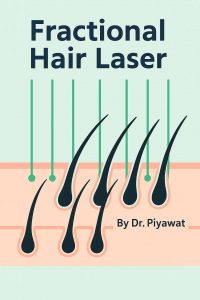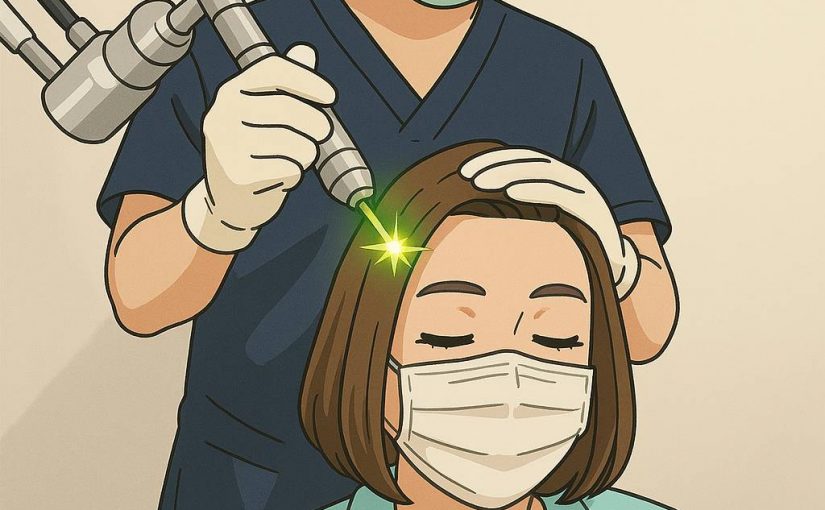Androgenetic alopecia (AGA) is a common condition that causes hair thinning in both men and women. It is primarily driven by androgen hormones and the sensitivity of hair follicles to dihydrotestosterone (DHT), which shortens the hair growth cycle and leads to gradual miniaturization of hair follicles, resulting in visibly thinner hair.
In recent years, laser technology, particularly fractional lasers, has gained popularity as a non-pharmaceutical treatment option for AGA. Studies have shown that laser stimulation can effectively rejuvenate dormant hair follicles and promote new hair growth.

What Is a Fractional Laser?
Fractional lasers emit energy in a fractionated pattern—tiny beams that penetrate the deeper layers of the skin while leaving surrounding tissue intact. This creates microscopic wounds (microthermal zones), which trigger a natural healing response that encourages tissue repair and regeneration.
Types of Fractional Lasers
There are several types of fractional lasers used for hair stimulation, each varying in intensity and effectiveness. Since individuals with hair thinning often have sensitive scalps, it is important to choose a gentle laser system to avoid unnecessary irritation.
Mechanisms That Promote Hair Growth
- Microthermal Zones (MTZs):
Fractional laser beams create microscopic thermal injury zones in the scalp. These trigger a wound-healing cascade that releases various signaling molecules such as growth factors and cytokines, which help reactivate weakened hair follicles and return them to the anagen (growth) phase. - Stimulation of Stem Cells Around Hair Follicles:
Fractional lasers stimulate the bulge area of the follicle, where hair follicle stem cells reside. This promotes the repair of miniaturized follicles and the formation of new, healthy hair strands. - Increased Scalp Blood Circulation:
Mild inflammation caused by the laser leads to vasodilation and increased blood flow to the scalp. This enhances the delivery of oxygen and nutrients to the hair roots, strengthening the hair and extending the anagen phase. - Improved Absorption and Efficacy of Topical Treatments:
Fractional laser treatment increases scalp permeability, improving the absorption of topical products or mesotherapy solutions. This synergy enhances overall treatment effectiveness. For best results, gentle, non-irritating formulations—such as natural extracts and growth factors—are recommended.
Who Is Fractional Laser Treatment Suitable For?
- Anyone with Genetic Hair Thinning:
Whether in early or advanced stages, fractional lasers can help restore hair follicle function and improve scalp health. - Individuals Avoiding Side Effects from Oral Medications:
For those concerned about side effects from medications like finasteride, dutasteride, or minoxidil, fractional laser is a safe and effective alternative. - People Looking for a Safe, Low-Downtime Option:
As a non-surgical procedure, fractional laser treatment requires minimal recovery time and allows patients to return to their daily routines quickly. - Post–Hair Transplant Patients or Those Planning Hair Transplants:
Laser therapy can be used before or after a transplant to support recovery and improve the growth and survival of transplanted follicles.
Summary
Fractional lasers are not only effective for skin rejuvenation but also play a key role in hair restoration for AGA patients. They activate biological repair mechanisms, stimulate stem cells, and improve scalp blood flow—all contributing to enhanced hair growth.
Ongoing laser treatment, in combination with a holistic care regimen and appropriate therapeutic agents, can significantly improve hair density, strength, and retention.
Clinical Observations from Piyawat Clinic
Clinical tracking at Piyawat Clinic has revealed important findings regarding the effectiveness of fractional hair laser therapy:
- Patients treated with fractional hair laser combined with Meso Hair showed significantly greater hair growth compared to those who received mesotherapy alone, with statistically significant results.
- New hair was observed growing from previously empty follicular areas (inter-follicular spaces) in patients treated with fractional hair laser + Meso Hair, more prominently than in those treated with mesotherapy alone—again, with statistical significance.
